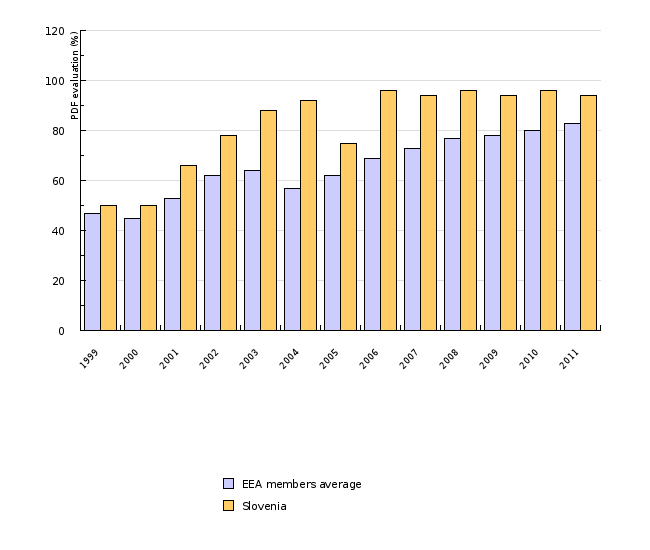[OP02] Reporting of environmental data

Definition
Reporting of environmental data is measured by and as the level of completeness of environmental data reported in compliance with the requirements stipulated by the European Environment Agency (EEA). This level is presented in an assessment established by the EEA in its annual Progress Report – Priority Data Flows in EIONET, hereinafter referred to as PDF, addressed to the Management Board of the EEA.
Charts
Progress Report – Priority Data Flows in EIONET, European Environment Agency, 2007
| 1999 | 2000 | 2001 | 2002 | 2003 | 2004 | 2005 | 2006 | 2007 | 2008 | ||
|---|---|---|---|---|---|---|---|---|---|---|---|
| EEA members average | % | 47 | 45 | 53 | 62 | 64 | 57 | 62 | 69 | 73 | 77 |
| Slovenia | % | 50 | 50 | 66 | 78 | 88 | 92 | 75 | 96 | 94 | 96 |
| 2009 | 2010 | 2011 | |||||||||
| EEA members average | % | 78 | 80 | 83 | |||||||
| Slovenia | % | 94 | 96 | 94 |
Comment
The obligation to report to the European Environment Agency by the Republic of Slovenia arises from Article 8 of the Agreement between the European Community and the Republic of Slovenia concerning the Participation of the Republic of Slovenia in the European Environment Agency and the European Environment Information and Observation Network, signed and ratified by the Slovenian Parliament (OJ RS – MP No 18/01) which determines that the Republic of Slovenia should provide data according to the obligations and practices established in the Agency’s work.
So far, we have communicated to the EEA reports on the state of water, air quality and air emissions, protected areas, state of soil, implementation of the CORINE Land Cover project, etc. The preparation and communication of reports is implemented through the EIONET Network in Slovenia.
The compliance of Slovenia’s reporting with the requirements defined by the EEA has been subject to assessment since 2000. In this period Slovenia has, as the majority of other EEA Member States, in particular new EU member states, shown significant progress. Decline of avrage evaluation value in 2004 was caused by inclusion of new reports in PDF, stricter criteria and accession (or collaboration) of new countries to EEA. Pursuant to the PDF criteria, Slovenian reports have achieved 96% conformity with the EEA’s reporting requirements, placing Slovenia in 3th place among 37 assessed countries.
Methodology
PDF is a set of six to twelve reports provided by the EEA, in due content and form, that EEA Member States are obliged to communicate to the EEA within a specified time limit in order for the latter to be able to use them in the preparation of its own reports. For the purposes of preparing annual progress reports, the EEA assesses each report (reporting) by using so-called “smileys”, i.e. points – 0, 1, 2 or 3. The sum of gathered points representing a share of all possible points that can be acquired by each assessed state constitutes an overall assessment of the level of completeness of environmental data collected in each state in accordance with the requirements stipulated by the EEA. The rating criteria are determined in advance and for each separate report, and relate in particular to the length and completeness of the time series of the data required and communicated, communication of the data in due time and form, etc. Every year are the critria slightly stricter. The quality of data communicated toll now has not been subject to assessment.
Results are taken from web presentation: Eionet priority dataflows (10.7.2007)
This indicator is also included in the compilation of indicators used for measuring the development of information society in accordance with the eEurope Plus Action plan.









